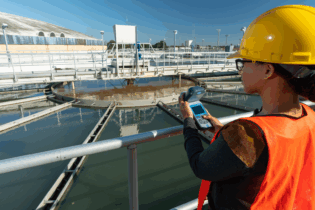At least 13% of South Africa’s water supply stems from groundwater, yet scientists are still unearthing new insight into this precious yet oft hidden resource.
The latest offering, published earlier this year by the Water Research Commission (WRC), consolidates the latest knowledge on a part of the Earth many people haven’t even heard of, namely the vadose zone. The publication, The vadose zone: From theory to practice (WRC Report No. TT 869/21) is edited by Matthys Dippenaar, Associate Professor in Engineering Geology and Hydrogeology at the University of Pretoria, who has led several studies on the vadose zone for the WRC during the last ten years. The co-authors of the publication are Brendon Joes, Louis van Rooy, Mampho Maoyi and Duan Swart. The vadose zone, also known as the unsaturated zone, comprises the area between the land surface and underlying groundwater aquifers. Unlike the aquifers of the saturated zone below, the vadose zone is not a source of readily available water for abstraction. This is perhaps the reason why the area has remained fairly unexplored until the last twenty years. Scientists have since discovered the significance of this area of the Earth. Firstly, it is of great importance in providing water and nutrients that are vital to the biosphere, and is intensively used for the cultivation of plants, construction of buildings and disposal of waste. In the groundwater context, it determines the rate of aquifer replenishment and, in some instances, acts as a buffer that limits contamination from surface or underground pollution sources, explains Dr Shafick Adams, WRC Executive Manager: Water Resources and Ecosystems, who managed the project. “In an engineering context, knowledge of the vadose zone is important for infrastructure development and the formation of hazardous situations, like subsidence or catastrophic events like sinkholes in dolomitic terrains. It is thus a critical area for groundwater and land-use planners.” Hydrologically, the vadose zone is often the main factor controlling water movement from the land surface to the aquifer. In addition, flow rates and chemical reactions in the vadose zone control whether, where, and how fast contaminants enter groundwater supplies. Understanding of vadose zone processes is therefore also crucial in determining the amount and quality of groundwater that is available for human use.“The vadose zone is a key area of the subsurface that links surface water inputs to what actually ends up recharging the aquifer,” notes WRC Research Manager, Yazeed van Wyk. More importantly, the capability of the vadose zone to remove pollutants also depends on the properties of the porous media that make up this zone.
“As a result, we need to further develop the knowledge base around the vadose zone Physico-chemical and hydraulic properties, which are very different to those of fully saturated media,” explains van Wyk. This is required to better manage the risks to drinking water sources that can possess long-term and concealed risks to human society from a contamination perspective. The latest publication is the product of a series of projects focusing on the role of the vadose zone in the hydrological and geotechnical behavior of materials, as well as those exacerbated by human impact. The guidebook combines the knowledge of various disciplines, such as hydrology, hydrogeology, engineering geology and others towards a single resource on this area of the Earth. The chapters guide the reader through various aspects of the subsurface, principles of unsaturated flow, the characteristics and functions of the vadose zone and how this information can be applied, for example, in wetland delineation, the protection of groundwater from contaminants, and in construction and engineering. The publication also contributes to, among others, the behaviour of the vadose zone, applications of vadose zone hydrology in different types of groundwater systems found in South Africa, and how the vadose zone is affected by human impacts. “This new publication plugs a gap in both our theoretical and practical understanding on the processes that govern flow and contaminant transport in the vadose zone,” notes Van Wyk. It is expected that the, The vadose zone: From theory to practicewill greatly contribute to efforts in addressing the consequences of urbanisation, land use change, and issues of climate variability on groundwater quality.







